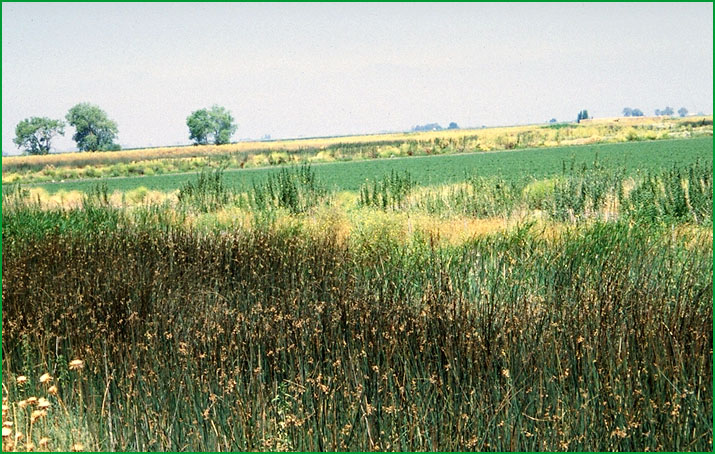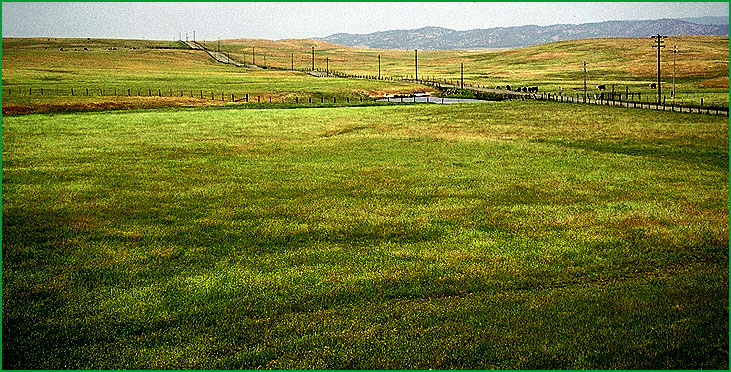 | Delta Basins - Winters Terraces - Camanche Terraces |
Delta Basins-Lodi area Ś Patsy Miles |
Camanche Terraces -south of Milton Ś Robert Ettner |
http://www.fs.fed.us/r5/projects/ecoregions/262am.htm
This subsection is in a low area of inorganic sediments along the eastern edge of the delta area of the Sacramento and San Joaquin Rivers. The climate is hot and subhumid. MLRA 17e.
Lithology and Stratigraphy. This subsection contains late Quaternary alluvium. Most of the alluvium is from granitic rock sources, but some is from volcanic, sedimentary, and metamorphic rock sources.
Geomorphology. This subsection is a nearly level plain. It is the deltas of the Cosumnes, Mokelumne, and Calaveras Rivers and basin floor with basin-fill from the overflow of these and the Sacramento and San Joaquin Rivers. The subsection elevation range is from sea-level to about 50 feet. Fluvial erosion and deposition are the main geomorphic processes.
Soils. The soils are mostly Aquic Xerofluvents; Pelloxererts; Cumulic and Duric Haplaquolls; Argic Durixerolls; Typic Durixerolls; and Chromoxererts. The soils are mostly somewhat poorly to poorly drained, and some are moderately well drained. Soil temperature regimes are thermic, and soil moisture regimes are mostly aquic and xeric.
Vegetation. The predominant natural plant communities are Needlegrass grasslands, Emergent aquatic communities in low areas along the edge to the delta, and Fremont cottonwood series along streams.
Characteristic series by lifeform include:
Grasslands: California annual grassland series, Purple needlegrass series.
Wetlands: Bulrush series, Bulrush - cattail series, Cattail series, Ditch-grass series, Sedge series.
Forests and woodlands: Fremont cottonwood series, Mixed willow series.
Climate. The mean annual precipitation is about 16 to 18 inches. It is practically all rain. Mean annual temperature is about 59░ to 62░ F. The mean freeze-free period is about 250 to 275 days.
Surface Water. Streams in this subsection drain to the delta area of the Sacramento and San Joaquin Rivers. All but the larger streams are generally dry during the summer. There are no lakes.
Subsection 262An
Winters Terraces
This subsection is on terraces with clayey soils along the western edge of the lower Sacramento Valley, adjacent to the northern California Coast Ranges. The climate is hot and subhumid. MLRA 15d.
Lithology and Stratigraphy. This subsection contains predominantly Pliocene nonmarine sediments that are only slightly consolidated. There are smaller areas of Quaternary terraces and recent alluvium.
Geomorphology. This subsection is on very gently sloping terraces that are dissected and eroded to form gently sloping to moderately steep slopes. There are small areas of recent floodplain and terraces along streams that cross from mountains of the northern California Coast Ranges to reach the Sacramento River. The subsection elevation range is from about 100 to about 200 feet. Fluvial erosion and deposition are the main geomorphic processes.
Soils. The soils are mostly Typic Palexeralfs, Typic Haploxeralfs, Entic and Typic Chromoxererts, and Typic Argixerolls. Soils on recent alluvium are Typic Xerorthents, Typic Xerochrepts, Aeric Haplaquepts, and Haploxeralfs. Most of the soils are well drained, but some in recent alluvium are somewhat poorly drained. Bicarbonate weathering and leaching and accumulation of clay in subsoils are the main pedogenic processes in the terrace soils. Soil temperature regimes are thermic. Soil moisture regimes are mostly xeric, with some aquic on floodplains.
Vegetation. The predominant natural plant communities are Needlegrass grasslands and Blue oak series. Fremont cottonwood series occurs along streams.
Characteristic series by lifeform include:
Grasslands: California annual grassland series, Needlegrass series.
Vernal pools: Northern hardpan vernal pools.
Forests and woodlands: Blue oak series, Fremont cottonwood series.
Climate. The mean annual precipitation is about 20 to 25 inches. It is practically all rain. Mean annual temperature is about 59░ to 62░ F. The mean freeze-free period is about 250 to 275 days.
Surface Water. Streams in this subsection drain to the Sacramento River. All but the larger streams are generally dry during the summer. There are no lakes, but there is temporary ponding in vernal pools on Pleistocene terraces.
Subsection 262Ao
Camanche Terraces
This subsection is on low hills and terraces along the eastern edge of the Great Valley, adjacent to the central Sierra Nevada. The climate is hot and subhumid. MLRA 17e.
Lithology and Stratigraphy. This subsection contains predominantly Eocene, Miocene, and Pliocene nonmarine sedimentary rocks. There are smaller areas of Plio-Pleistocene terraces and recent alluvium.
Geomorphology. This subsection is on gently sloping to moderately steep hills and dissected terraces. There are small areas of floodplain and recent terraces along streams that cross from mountains of the central Sierra Nevada to reach the Sacramento and San Joaquin Rivers. The subsection elevation range is mostly about 200 to 600 feet, but up to 1211 feet on Valley Springs Peak. Fluvial erosion and deposition are the main geomorphic processes.
Soils. The soils are mostly shallow Typic and Ultic Haploxerolls, shallow Typic Xerochrepts, Lithic Mollic Haploxeralfs, and Ultic Palexeralfs. On Plio-Pleistocene terraces there are Haploxeralfs, Palexeralfs, and Durixeralfs. Fluventic Haploxerolls and Aquic Xerofluvents are common on floodplains. Most of the soils are well drained, but some in recent alluvium are somewhat poorly drained. Bicarbonate weathering and leaching and accumulation of clay in subsoils are the main pedogenic processes, plus accumulation of silica in the subsoils of terrace soils. Soil temperature regimes are thermic. Soil moisture regimes are xeric, with some aquic on floodplains.
Vegetation. The predominant natural plant communities are Needlegrass grasslands. There is some Blue oak series, and Northern claypan vernal pools are common. Fremont cottonwood series occurs along streams.
Characteristic series by lifeform include:
Grasslands: California annual grassland series, Purple needlegrass series.
Vernal pools: Northern claypan vernal pools.
Forests and woodlands: Fremont cottonwood series, Mixed willow series.
Climate. The mean annual precipitation is about 20 to 25 inches. It is practically all rain. Mean annual temperature is about 58░ to 62░ F. The mean freeze-free period is about 250 to 275 days.
Surface Water. Streams in this subsection drain to the Sacramento River. The Cosumnes, Mokelumne, Stanislaus, and Tuolumne Rivers cross the subsection. All but the larger streams are generally dry during the summer. There are no lakes, but there is temporary ponding in vernal pools on Pleistocene terraces.

